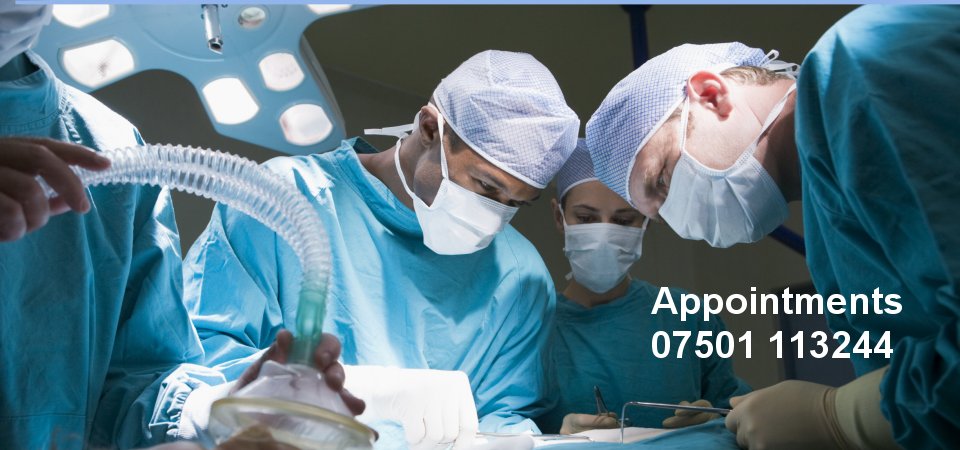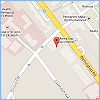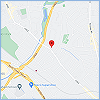What is an incisional or umbilical hernia?
An inguinal hernia is an outpouching of the internal lining of the abdominal wall. It occurs in the groin and can descend towards the scrotum or labia, and represents a weakness of the abdominal wall. It can occur therefore as a result of raising the intra-abdominal pressure such as heavy lifting, excessive coughing or sneezing etc. It is not therefore surprising to know that inguinal hernias can be found in both groins at the same time (bilateral inguinal hernias), or can develop on the other side in the future. Whilst it is rare, a strangulated hernia is where the bowel gets ‘stuck inside’ the hernial outpouching. It is an emergency and causes a permanent irreducible lump in the groin associated with vomiting, abdominal pain and distension. A recurrent hernia is one which re-occurs on the same side at any time after a previous hernia repair on that side.
What is the treatment?
Surgery is the only definitive treatment, although a truss (a belt with an occlusive patch covering the hernial defect) can be used temporarily in certain inguinal hernias. The best type of surgical repair with the lowest rate of recurrence involves securing a ‘nylon mesh’ to bridge the defect.
There are two main surgical approaches:
- open mesh repair – via a cut in the groin the hernia is repaired and mesh inserted
- laparoscopic mesh repair – ‘keyhole surgery’ where a telescope is inserted through small incisions into the abdomen, the hernia repaired and the mesh inserted ‘from within’
Which surgical treatment is best?
Both open and laparoscopic mesh repairs have exactly the same hernia recurrence rates of about 1%. The major disadvantages of open repairs are the longer period of recovery (5-6 weeks versus 2-4 days laparoscopically), and higher risk of mesh infections (which normally mean the mesh will require removal). Because laparoscopic hernia repairs are performed with ‘telescopes’ through the abdomen,the main disadvantages are of damage to bowel or blood vessels in the abdomen, and whilst these complications are rare they are more serious.
If you have bilateral hernias or perhaps we are not sure if you have a hernia on the other side as well, then the laparoscopic method is best since we can look with the
laparoscope to check whether you really do have bilateral hernias, and then repair them both at the same time without any other cuts (unlike open surgery for bilateral hernias with a larger cut in both groins). Similarly, if you have a recurrent hernia having had previous open surgery on that side then a laparoscopic approach is best, since the tissues are ‘fresh’ and un-scarred from within the abdomen.
Generally patients report less pain from the laparoscopic repair, but please note that keyhole approach is not ‘magic’, there will still be some pain and discomfort post-operatively.
What happens next?
Once we have agreed which type of mesh repair would suit you best, then a date will be set for your surgery. Usually, you will be ‘pre-admitted’ in the week before surgery where blood tests and perhaps chest X-rays and a heart recording will be taken. You will be admitted a few hours before the approximate planned time of surgery having had nothing to eat for six hours before the start time (you may drink clear fluids and take any medications up to 3 hours before surgery). After your surgery you will wake up in the recovery room, and then be transferred back to your hospital room. Later the same day you may have something to eat and drink if you wish. Most people who have a laparoscopic hernia repair can be discharged home the following day, and occasionally the same day. It is usually a good idea to get some paracetamol and ibuprofen (as long as you can take these) in the house in preparation for your return. Additionally, it is wise to buy some Fybogel or lactulose to avoid any constipation and straining.
How long will I be ‘out of action’?
You can expect to have some minor discomfort which will gradually subside at 2 weeks after surgery, but this takes a little longer with the open method of mesh repair, perhaps by another 2 weeks or so. With both types of surgery there will inevitably be minor twinges thereafter for a few months as the tissues around the mesh organize themselves. You will be advised to take gentle exercise but no heavy lifting or strenuous work for 6 weeks by which time you will have been seen for a follow-up appointment in the outpatients department and will be advised at that time. You will probably be off work for 5-6 weeks with open surgery, and 2-3 weeks with the laparoscopic method. You may drive a car when you are able to perform an emergency stop and turn around fully when seated to look behind you, but for most people this will be 5-10 days.
Sometimes immediately after the surgery you might notice a small lump in the groin rather similar to the original hernia. Don’t worry, the operation hasn’t gone wrong, this is just a fluid reaction to the mesh and surgery (a haematoma or seroma), and this will subside in a few months.
Any questions and preauthorization always contact my office 07501 113244 before your procedure.
If post operatively you experience any problems please contact my office on 07501 113244 during office hours. Out of office hours please contact either the Wellington Hospital on 0207 483 5148 The Kings Oak Hospital on 0208 370 9500 or The Cavell Hospital on 0208 366 2122 and ask to be put through to the ward




